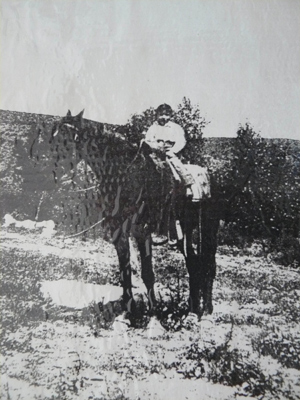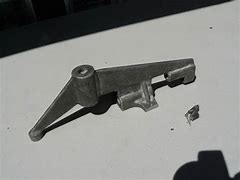By Charles Lear
 When it comes to reported UFO crash locations in New Mexico, everyone has heard of Roswell, many have heard of Aztec but few have heard of San Antonio. San Antonio is a small village, 12 miles south of Socorro just northeast of White Sands Missile Range. It was the childhood home of two men, Reme Baca and Jose Padilla who, in 2003, came forward with the story that they had discovered a crashed UFO there in 1945.
When it comes to reported UFO crash locations in New Mexico, everyone has heard of Roswell, many have heard of Aztec but few have heard of San Antonio. San Antonio is a small village, 12 miles south of Socorro just northeast of White Sands Missile Range. It was the childhood home of two men, Reme Baca and Jose Padilla who, in 2003, came forward with the story that they had discovered a crashed UFO there in 1945.
In 2002, Reme Baca and Jose Padilla were living in Washington State and California respectively. Padilla left San Antonio in 1954 and Baca left in 1955. According to Baca, there was no contact between them from 1955 to 2001. They renewed contact after coming across each other while searching their ancestry on the internet. In the course of their conversations, they revisited an unusual series of events from their childhood. They got in touch with an old schoolmate, Ben Moffett, who was a reporter for the Socorro newspaper, The Mountain Mail. They related the events to him in 2003 and he published their tale as a two-part series in the November 2 and November 6, 2003 editions.
On July 16, 1945, the world’s first atomic bomb was detonated at the Trinity site, which is approximately 40 miles from San Antonio. Jose Padilla and his mother were up early that day and when the bomb went off, his mother observed it through a crack in the door and lost her sight in one eye. Residents of the area were told that what they had witnessed was the accidental explosion of a munitions dump. A month later, on or near August 16th, Reme Baca, age 7, was with Padilla, age 9, helping out on the ranch owned by Padilla’s father, Faustino. They were tasked with finding a cow that had wandered off to give birth and they set out on horseback. That children that age would be helping out as ranch hands may seem extraordinary to us modern folks, but a picture of Baca on horseback confirms that he was, at least, able to ride at that age.
They rode until the ground became too rough for the horses and they dismounted and tethered the horses and continued on foot. The headed for a thicketed spot a cow would likely seek out for giving birth when a thunderstorm came upon them causing them to seek refuge under a ledge. The storm passed quickly and then there was a flash of light, the sound of an impact and the ground shook violently. They moved on and came upon the cow where they thought she would be along with her newborn calf. They stopped to have lunch and, as they were eating, they saw smoke rising from an area near Walnut Creek, which is a tributary leading to the Rio Grande. This led them to investigate and when they came over a hill they saw a gouge that was as long as a football field with a large, ovoid, dull grey metal object at the end of it. The heat from the wreckage and burning creosote bushes kept them away for a short period. They took some time to cool off, drink some water and gathered their nerve to get close enough to look for any casualties. As they approached, they took some time to examine debris that was scattered in the area and Baca described picking up and keeping a piece of foil that returned to a flattened state after being crumpled.
Using binoculars, the boys were able to see inside the object through a hole in it caused by the crash. Baca reported seeing small creatures moving quickly as if they were under stress and that they seemed to “will themselves from one position to another in an instant.” Despite concerns for the creatures’ well being, fear, exhaustion and oncoming darkness caused the boys to return to the Padilla house. They told Faustino that they’d found the cow and her calf and then described the crash, discovery of the object and seeing the creatures. The elder Padilla was unconcerned and felt it was probably something that had gotten away from the military. He agreed to go out to look within the next couple of days and two days later, the boys guided Faustino accompanied by state policeman and family friend, Eddie Apodaca, out to the site.
When they got there, they couldn’t find the object at first due to the angle of the sun and dirt and debris on the object, which helped to further obscure it. When they were close enough to see the object, they noticed that the debris had been cleaned up and that there were rake marks on the ground. There were no creatures to be seen and Faustino speculated that the boys just imagined seeing them, someone had taken them or they had just left. Faustino and Baca’s father both had government jobs and Faustino advised the boys not to talk about what they had seen. Apodaca offered that he was there to help Faustino arrange with the government for the object’s recovery and told the boys that the Army referred to such things as weather balloons.
Two days later, the Army began a recovery operation. They said nothing about it to the public and, as Apodaca said they would, told the Padillas that the object was a weather balloon. They took down some of Padilla’s fence, installed a metal gate and graded a road out to the site. They asked Faustino to help with security and to tell anyone who was curious that the government was working a manganese mine on the property.
The boys snuck onto a nearby ridge and watched as the soldiers worked. Baca described the work as being not very “efficient” and said he saw the soldiers throwing parts they didn’t want to carry into a crevasse which they covered with dirt. The object was too big to sit on the flatbed truck they’d brought in so an L-shaped frame was built to accommodate it. When they got the object onto the truck they covered it with a tarp and then went off to the nearby Owl Bar and Cafe for some refreshment. The boys, who were interested in getting a souvenir, saw their chance and Padilla climbed in through a hole in the side while Baca held up the tarp. Once inside, Padilla saw no seats or instruments but there was a bracket on a wall he thought he could break off. They got a cheater bar (used to insure tie down tightness) from the front of the truck and Padilla used it to pry off the bracket.
 The Army took the object away but the boys had the bracket and the foil. Baca said he kept the foil in a Prince Albert tobacco can for four years until he used it to fill in the stripped threads of a leaky pipe under a windmill at his house. The property was no longer owned by anyone in his family and the windmill was long gone. They did manage to hold onto the bracket and made arrangements to have it tested.
The Army took the object away but the boys had the bracket and the foil. Baca said he kept the foil in a Prince Albert tobacco can for four years until he used it to fill in the stripped threads of a leaky pipe under a windmill at his house. The property was no longer owned by anyone in his family and the windmill was long gone. They did manage to hold onto the bracket and made arrangements to have it tested.
Researcher Paola Harris came upon the case and arranged to fly out to Washington State to interview Baca in 2010. Baca was then in his 70’s as was Padilla and they had written a book about their experience, “Born on the Edge of Ground Zero, Living in the Shadow of Area 51” which was published in 2011. Baca’s and Padilla’s story as told to Harris was similar to the one they’d told Moffett but had more details. They described the creatures as “squealing” with Baca saying it was like a jackrabbit in pain and Baca also added that they had heads like a bug’s with large, bulging eyes.
Baca and Padilla expressed an interest in excavating the crevasse where the debris was buried but that doesn’t seem to have happened. They did get the metal bracket tested and the results were published on the The Black Vault website. The metal was a common cast aluminum alloy used to make engine parts, crankcases, gas tanks and oil tanks. All isotope ratios were terrestrial and it seems likely that the object was as well.
This writer is inclined to believe that the boys saw something that was part of a military test gone awry. If that was the case, the fact that a large object came crashing to earth that close to two young boys who, just one month previous, had been less than 40 miles from an atomic explosion is extraordinary in itself. It also doesn’t say much for the government’s regard for the citizens of San Antonio in 1945.